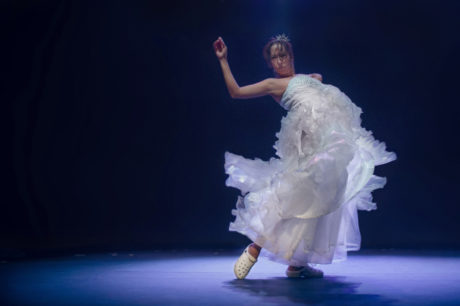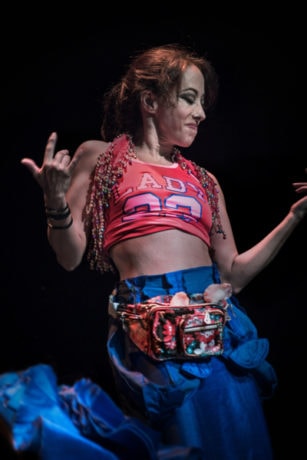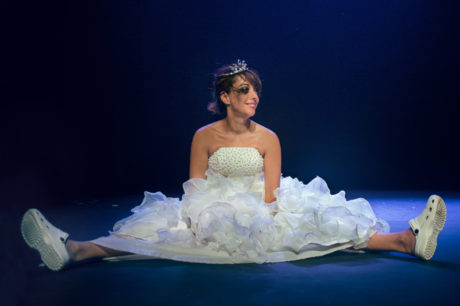The life of a Gypsy is hard. For centuries the Romany people, who are commonly referred to as Gypsies, have been persecuted across Europe. They have been discriminated against and have been subjected to forced sterilizations and ethnic cleansings. In her one-woman show Romnia (which means “women” in the Romany language), Belén Maya interprets the struggles of these women in dance at Drexel University’s URBN Black Box Theater.

Belén Maya is Artist in Residence this month at Drexel’s Westphal College of Media Arts and Design. She is also a celebrated flamenco dancer from Spain, well known for her contemporary approach to flamenco, which pushes the boundaries of the genre.
In the program, the notes for this piece are aptly subtitled: “It doesn’t seem like Flamenco.” It’s not – at least, not in the traditional sense. The costumes are different and the music is not live. There is no gypsy singing and guitar playing. Maya sometimes dances barefoot! The original idea and the musical direction for this experimental dance concert are attributed to Joaquín López Bustamente.
Maya purposely avoids using Spanish or flamenco music in Romnia, but her technique and style are an extension of flamenco. In a discussion after the October 13th performance, Maya explains that she did not want to limit herself to the traditional flamenco genre for this piece that focuses on Eastern European Romany women. She felt that her creativity and movement would be constrained if she did, and rightfully so. Maya’s parents were both accomplished and famous flamenco dancers in Spain, so she grew up in that milieu in her personal life as well as in her later dance training. Her father, Mario Maya, was also Romany. In Spain, flamenco is an integral part of the Romany or gitano culture. In Andalusia especially, it is not just professionals who dance and sing it—it is part of celebrations and every day life.

Using recorded music from Bulgaria, Russia, the Czech Republic and Romania, Maya sometimes employs intricate footwork, turns and other movements from flamenco and builds on them. Because of the special flamenco shoes, the feet also function as a percussion instrument, creating their own sonic rhythm. Her choreography encompasses other non-flamenco elements in order to communicate the emotions and often-painful experiences of the Romany women. The dances express domestic abuse, suffering in a Nazi concentration camp, a gypsy wedding, begging in the street, as well as circuslike entertainment and a group dance.
The dance that explored domestic abuse and the group dance with audience participation highlighted two extremes of a Romany woman’s existence. Although the subject matter is grim and depressing, Maya artfully depicts the anguish and hopelessness of a woman who is involved in an abusive relationship. This is quite a feat for a one-woman show! Her knee-length skirt suggests the street clothes of an “ordinary” woman, not professional or street performer.
Maya is at her finest displaying rapid complex footwork and using her own hands to pull her hair. She works the entire black box stage. At one point she covers her face with hair and a hand, yet continues to dance blindly. Even though there was only one person on stage, I imagined the other individual who has beat her and silenced her. In this particular moment, with her face completely obscured and the hand pushing her back, she is obliterated as a person and doesn’t matter. The imagery is strong and clear, the choreography, masterful and the execution is virtuosity. The effect is sublime.
In contrast, towards the end of the program, there is a light and fun group dance. Maya invites about ten people from the audience to join her on stage. She then teaches them a simple combination that they perform with gusto. They look like they are having a great time and Maya is euphoric. This is a kitschy happy dance that is enjoyable to watch, accompanied by a bouncy rhythm and flashing lights. Light design is by Ana Yacobi.
Maya’s costumes, which she designed herself, support the dances and delineate her characters. Costume changes are woven into the performance and take place on stage. The costumes include a white wedding dress, a sheer long black dress with a flamenco train in the front (normally it would be in the back), wooden clogs, fanny pack, a blue dress and a “mantón.” A mantón is a very typical large Spanish shawl. Especially significant are the wooden clogs, which were worn by prisoners in the Nazi concentration camps.
Belén Maya blends history, realism, emotion, dance and culture into an enticing, thoughtful and gratifying production. In just one hour, through dance, Romnia increases awareness of the historical and current struggles of Eastern European Romany women. The experience is intense, and at times disturbing, but overall beautiful.
Westphal College of Media Arts and Design will be presenting a free and open to the public dance lecture and demonstration by Belén Maya at the Mandell Theater on Thursday, October 19.
Running Time: 60 minutes, with no intermission.

Romnia performs through October 14, 2017 at the URBN Black Box Theater at Drexel University — 3401 Filbert Street, in Philadelphia, PA. For more information on Compañía Belén Maya events, visit her website. For tickets, purchase them online.




